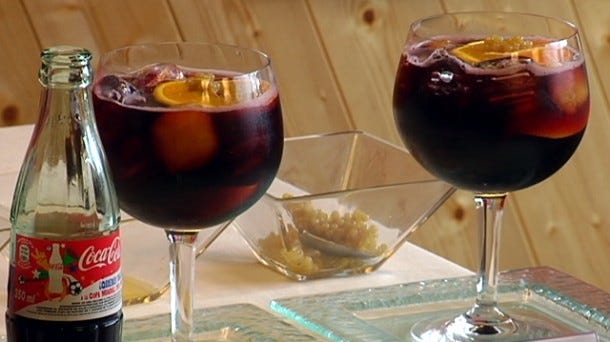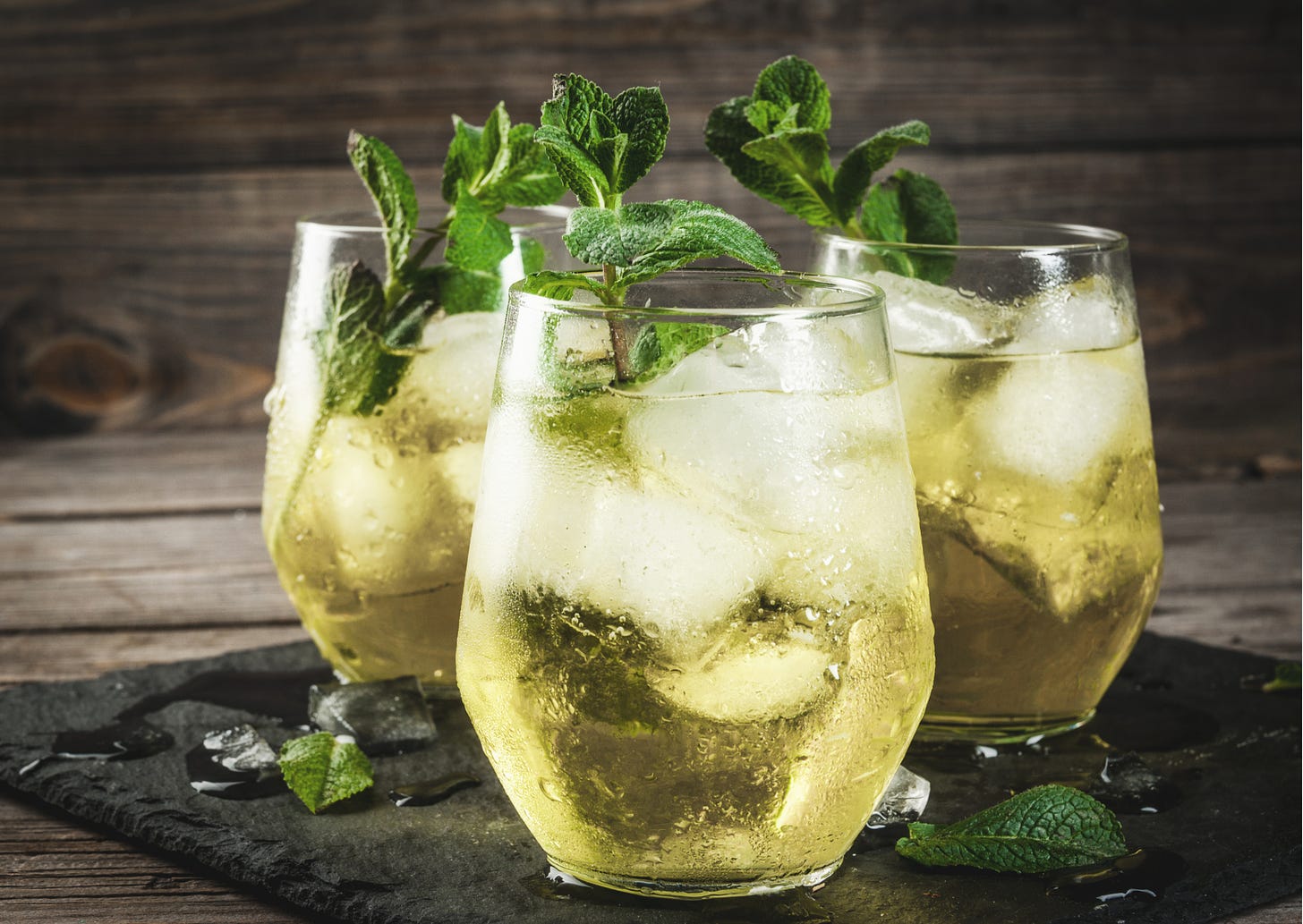🍷 2000-Year-Old Wine and 6 Easy Wine Cocktails.
The surprising discovery of some ancient Roman wine, a short history of wine production in Spain, and six popular and easy to make wine cocktails.
You can find a good bottle of Spanish wine just about anywhere these days. After Italy (and France depending on which statistics you believe) Spain is one of the world’s biggest exporters of wine. In 2022 Spain was a close second behind Italy, exporting 2.12 billion litres, and the popularity of Spanish wine around the world continues to grow.
I’ve talked about Spanish wine a few times at Food and Fiesta, such as the grape harvests celebrated around the country, the Rioja wines, a little of Rioja wine history and the world famous, yet messy Wine Battle of Haro, wine and cheese pairings , the Galician Albarino festival, and even a red wine risotto recipe.
Because wine is Spain’s thing.
Wine production in Spain goes back a mind-blowingly long time, with evidence now showing that vines were likely growing (and possibly even planted) on the peninsula as far back as the late Tertiary period some 2.6 million years ago. It’s unlikely our pre-Sapien ancestors were fermenting grapes, but you never know…..however, the Phoenicians definitely were when they arrived in Cadiz some 3 millennia ago.
After the Phoenicians, the Carthaginians were next to occupy the peninsula and took winemaking a step further. But when the Romans came and claimed the land for the Empire, they changed the winemaking landscape forever, setting the stage for Spain’s amazing viticultural future.
Hispania’s main production areas were Tarraconensis near Barcelona in the north and Baetica in the south (now known as Tarragona and Andalusia) and their wine was a popular import throughout the colonies. However, this Golden Age was to end with the arrival of the barbarians from the north of Europe. These Visigoths didn’t add a lot to Spain’s cultural history, especially wine production – beer was probably more their poison – so further production had to wait for the arrival of the Moors a few hundred years later.
The invading Muslim forces who enthusiastically entered Iberia from the south picked up the reins of winemaking again despite alcohol being prohibited in their religion. There were those who were quite flexible on the subject of winemaking and drinking, and of course there were the Jews and Christians who still lived on the peninsula and were also partial to a drop. Because of the Moors’ deep and useful knowledge of irrigation, agriculture and viticulture flourished.
But let’s go back to Roman Hispania and a cool discovery
There are very few remaining examples of early wine in Spain, or anywhere in the world for that matter because liquid tends to evaporate over time, even in a well-sealed pot. So it came as a great surprise to the researchers from the University of Cordoba to find the 2000-year-old cremated bones of a 45 year old man, a gold ring, and pieces of carved bone immersed in a glass urn full of a reddish bubbly liquid. The wine and remains were located in a mausoleum along with five other funerary urns from the 1st century CE.
“What gave us the certainty that it was wine were the polyphenols,” Ruiz Arrebola tells elDiario.es. "What we see are the characteristic molecules of the wine, without a doubt, in fact we have compared them with wines from the area and the same compounds are present."
Because they found no anthocyanins, which are the polyphenols created during the production of red wine, the researchers have come to the conclusion that it was white wine. The fact there is wine at all is also surprising because it’s not a common aspect of the funereal ritual, although it was connected to various religious practices.
Whether Professor José Rafael Ruiz Arrebola and his team from the Department of Organic Chemistry of the UCO decide to brave a sip still remains to be seen. “I don't think it's dangerous, but it makes me a little sick, especially since it was in contact with the remains of a dead Roman”.
Fortunately that won’t be necessary.
Spanish wines have come a long way in the last 2000 years and even though there have been many royal decrees throughout the centuries that attempted to regulate the quality of production, it wasn’t until the 1920s that Spain began the DO (Denomination of Origin) classification system. La Rioja, the region most famous for its wines and one of the oldest, was the first to receive this appellation back in 1925 followed by Sherry from Jerez in Andalusia in 1933.
This appellation, among other more modern ones awarded to the best wines in Spain, have helped give them their international prestige and ensures they maintain their high standard. There are more than 70 Designations of Origin used to classify the different types of wines in Spain which serve to unify the common characteristics, the “terroir” if you will– the influence of climate, soil bacteria, and water. Some of those wines include DO Jerez, DO Jumilla, DO Penedes, DO Rias Baixas, and DO Ribera del Duero.
While there are so many famous and popular wines on the market, some of the smaller, lesser-known wineries around the country are also worth visiting for their extraordinary quality of wines.
And who doesn’t love a wine cocktail?
Below are several of Spain’s most popular mixed wine beverages that won’t have you passed out under the table - from the more complex Sangria and Zurracapote full of fruits, because what better combo is there?… to the quick simple Tinto de Verano and surprising Kalimotxo, the luscious minty Rebujito or sparkly Agua de Valencia.
Sangria
We need to start with the most well-known and easy to pronounce for the summer tourists - Sangria. There are many variations of this drink, including substituting red wine for white, but here is a classic which is easy to make, flexible when it comes to what kind of fruit or wine you have on hand, and is the perfect drink for a hot day.
Sangria is traditionally made with red wine (the name born from the word ‘sangre’ meaning blood) but white sangria is made with white wine and even Cava (the Spanish version of Champagne). Any types of fruit can be added, depending on preference, but firmer fruits like apples and pears, and especially citrus fruits such as oranges and lemons are a popular choice.
1 litre of red wine
2 peaches
½ lemon
2 oranges
50ml lemon juice
50g sugar
150ml of fresh orange juice
1 strip of lemon peel
50ml brandy (optional)
I personally like to put a little lemonade in it for a touch of fizz and to make it less concentrated, but the purists may find that sacrilegious. 🤐
Peel the peaches, remove the stone, and chop into pieces.
Peel the oranges and lemon and also slice into pieces.
Marinate the fruit with the sugar and brandy for around 2 hours.
In a large jug, add the red wine, orange, and lemon juice and peel to the fruit mixture.
Serve the drink chilled and with plenty of ice. If you don’t plan to drink it all at once, it’s better NOT to add the ice to the jug as it will make the drink watery.
Tinto de Verano
As the name suggests, this is a popular drink in summer and super easy even for the laziest of us who just want a refreshing alcoholic drink without the hangover.
Made with inexpensive red wine and gaseosa – a type of lemonade – and a handful of ice cubes thrown into a large glass.
Fill the glass halfway with red wine of choice.
Fill the rest of the glass with lemonade of choice, eg: SevenUp or Sprite.
Note: commercial lemonade - at least in Australia and the UK - has little to do with lemon. It’s usually a clear carbonated liquid similar to tonic water but sweeter.

Kalimotxo
When I first heard of this combination, a part of my soul died, but turns out it’s actually very refreshing and a popular choice for students who buy cheap wine in bulk, mix it with cola in large plastic bottles, and spend the night roaming the streets and parks getting slowly pissed. At least it used to be - now I think they prefer getting pissed faster so choose harder spirits with their soft drinks.
Apparently the name Kalimotxo dates back to 1972 in the Basque Country and was invented by a group of friends who mixed cola with sour wine to make it taste better. Even ancient Greece was known to mix lower quality wines with non-alcoholic liquids to make them more drinkable! And it certainly can turn a cheap wine into a very thirst-quenching concoction. Serve with ice and a slice of lemon and you may be surprised how good it is.
Fill a glass halfway with wine of choice.
Fill the rest of the glass with cola.
Add ice and slice of lemon.
Rebujito
Invented in Andalusia, this delicious cocktail is drunk in Andalusian festivals such as the Feria de Abril, the Horse Fair de Jerez, the Flamenco Festival of Jerez, the Feria de Cordoba, El Rocio and anywhere and everywhere else that needs an even greater excuse to break open a bottle of Manzanillo or Fino sherry.
Mixed with lemonade and a generous addition of mint leaves, this is a firm favourite with locals and tourists alike.
300ml dry sherry such as Fino or Manzanillo
600ml lemon soda or lemonade
Ice cubes
Peppermint leaves
In a cold glass add the sherry, soda and ice cubes. Garnish with a handful (or to taste) of peppermint leaves.

Agua de Valencia
Reminiscent of a Mimosa or Buck’s Fizz (the drink not the band) but with a bigger kick, Valencia’s famous cocktail is so named because it’s as easy to drink as water. The sweetness of the orange juice masks the more potent additions of gin and vodka, and if not careful, this one may indeed leave you under the table.
Galician painter Constante Gil came up with this one in 1948 shortly after arriving in Valencia. The region is famous for its oranges and the sweet juice was a delectable addition to Cava. Since the 70s, the drink has been a staple in Valencian nightlife and has become a symbol of the city.
700 ml Cava or other sparkling wine of choice
250 ml orange juice
40 ml vodka
40 ml gin
Serve very chilled, preferably in frosty glasses.

Zurracapote
Typically drunk in La Rioja province and especially enjoyed during the harvest festivals, Zurracapote is often offered free around the streets from chamizos (roadside stalls) and in bars and restaurants in the towns and cities.
Like Sangria, there are many variations of this drink with fruits of choice added, such as peach, orange, banana…but the principle ingredients remain the same. In Calahorra, the second largest city in the region after Logrono, they hold zurracapote-making competitions and drinking contests from the traditional porrón (pigskin).
Zurracapote can be served warm for a nippy winter’s evening, or chilled with ice. It can be made with red or white wine, though red or a mixture of the two is more common.
Ingredients for one bottle of wine. Adjust quantities for more.
Red wine 750ml
95ml water
70g sugar
2 small lemons
1 cinnamon stick
Heat about half the water on a low heat and add the sugar until completely dissolved and syrupy.
Put wine in a jug. Add cooled syrup to the wine
Simmer the cinnamon stick in the remaining water for about 2 mins.
Add to mixture when cooled along with the juice of the 2 lemons.
Add the peel from the lemons and the cinnamon stick to macerate in wine mixture for 4 days.
The longer you macerate, the higher the alcohol content and lower the sugar content.
Served chilled with chunks of fruit (optional)









